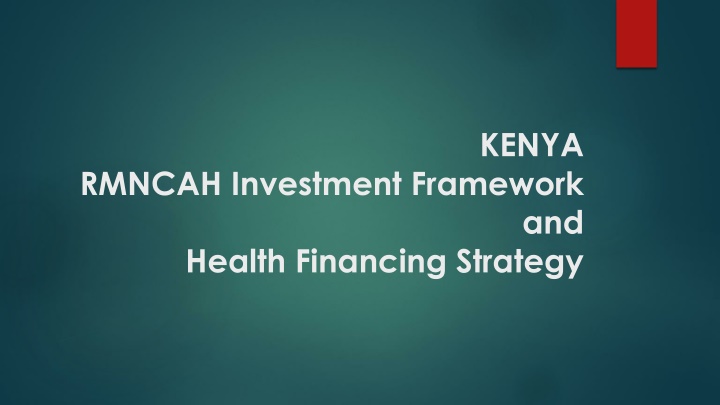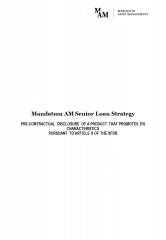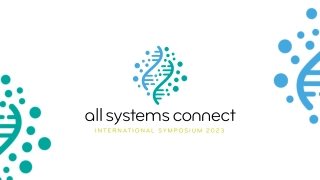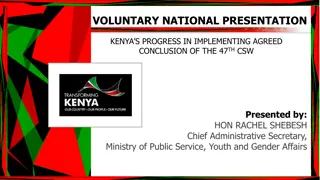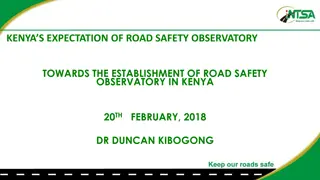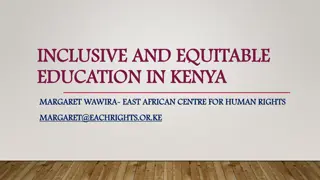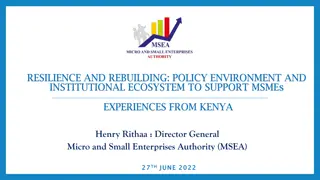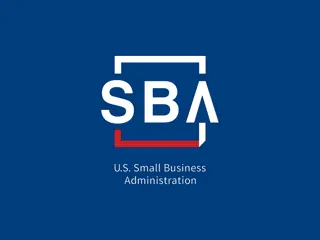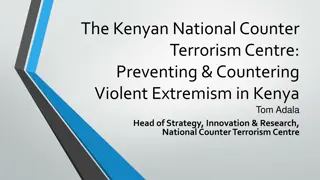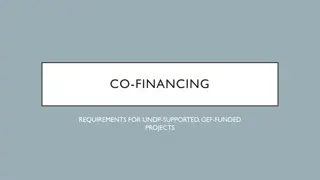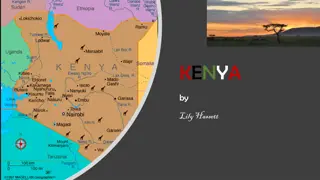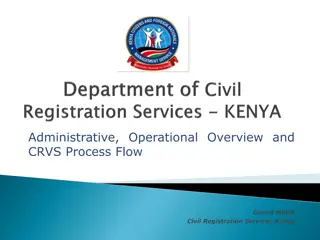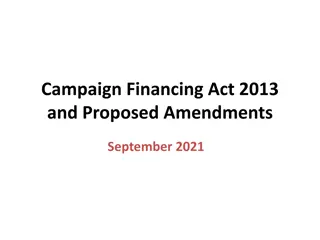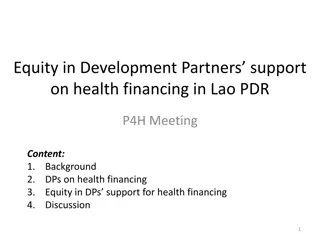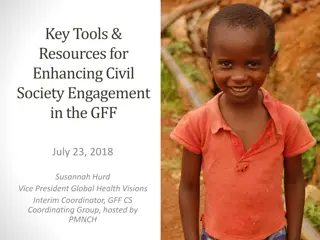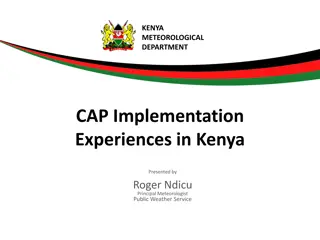Kenya RMNCAH Investment Framework and Health Financing Strategy
Kenya is making progress in reducing child mortality, improving maternal health services, increasing contraceptive use, and addressing stark regional inequalities. The RMNCAH investment framework outlines key drivers, challenges, and gaps in health financing strategy designed to enhance maternal and child health outcomes in Kenya.
Download Presentation

Please find below an Image/Link to download the presentation.
The content on the website is provided AS IS for your information and personal use only. It may not be sold, licensed, or shared on other websites without obtaining consent from the author.If you encounter any issues during the download, it is possible that the publisher has removed the file from their server.
You are allowed to download the files provided on this website for personal or commercial use, subject to the condition that they are used lawfully. All files are the property of their respective owners.
The content on the website is provided AS IS for your information and personal use only. It may not be sold, licensed, or shared on other websites without obtaining consent from the author.
E N D
Presentation Transcript
KENYA RMNCAH Investment Framework and Health Financing Strategy
Outline Investment Framework Diagnostic Process Vision, theory of change Implementation, expected benefits, complementary financing Health financing strategy Process Challenges, lessons learned, and takeaways
Kenya is making progress in reducing child mortality and improving maternal health services
Contraceptive use increasing and fertility declining Contraceptive Use Fertility
Despite recent progress, stark regional inequalities Skilled Care during Childbirth Children fully immunized * Inequitable coverage in some areas and groups such as adolescents requires additional investments.
Other Key GAPS Continued demand and supply barriers in scaling-up of high impact interventions. Sub-optimal functioning of the health systems Poor workforce distribution and low productivity Funding gaps for essential RMNCAH commodities and supply chain Incomplete and poor quality of data from routine health information systems Devolution dividend still needs to be fully optimized due to capacity challenges at national and county levels. Major contextual factor: decentralization
The RMNCAH investment framework is the outcome of an 8 month long country-led development and consultative process Key drivers Political Commitment: Improving RMNCAH services is a priority as reflected in Vision 2030, the Constitution of 2010 and the Health Sector Strategic and Investment Plan 2014-18. Enabling policies and initiatives: Free Maternity Services, elimination of user fee for primary care and the Beyond Zero campaign to address the critical barriers. Inclusiveness: Civil society, Faith Based Organizations (FBOs), private sector, professional associations and development partners. Country leadership: Two MOH-appointed national consultants and two focal points from the Planning, Policy and Health Financing Unit and the Division of Family Health facilitated.
Process policy and technical consultations High Level Policy Consultation: January 21 23, 2015, Naivasha Set the Agenda - Over 100 stakeholders participated, including multiple governors I st Technical Consultation: February 23- 27, 2015 followed by Stakeholder consultation on March 2, 2015 Reviewed existing policies and strategies and identified key implementation bottlenecks II nd Technical Consultation: April 21-30, 2015 Established methodology for data Triangulation and prioritization of interventions, population groups and costing approach. III rd Technical Consultation: June 9-25th Draft RMNCAH investment framework. Detailed review by Technical experts from MOH and H4 Plus partners Validation meeting July 31, 2015
THE VISION A Kenya where there are no preventable deaths of women, new-borns or children; no preventable still- births and where every pregnancy is wanted, every birth celebrated and accounted for; and where women, babies, children and adolescents are free of HIV/AIDS, survive, thrive and reach their full social and economic potential.
The Theory of Change Reduced morbidity and mortality and improved quality of life of among women, children and adolescents (MMR, U5MR,NMR, TFR, Teen pregnancy) Enhanced socioeconomic development from optimizing the demographic and devolution divided Impact Improved Equity Between Counties Between urban & rural residents Between rich and poor Enhanced efficiency High impact interventions Evidence based decisions Financing based on Results Effective coverage Universal Health Coverage Access to Quality RMNCAH & essential health Services Financial Protection Outcome Strengthened Health systems Productive health workforce Commodity security Health financing to ensure sustainability Health information including CRVS Good Governance Improved Service delivery Priority focus on high burden & underserved Counties, Groups (e.g. pastoralists) and Services (e.g. Adolescents) Innovations: Integrated services; PPP Enhanced Community engagement & citizen s participation Demand side incentives Advocacy for action Social accountability Gender focus Outputs Political commitment, devolution, epidemiological and demographic transitions, food security, climate change, migration, and security Social determinants: education, water and sanitation, roads, transport, human and reproductive rights
Key Strategies Investing in best buys of proven high - impact, evidence - based interventions that address demand and supply obstacles. Maximizing long term impact by investing in young people especially adolescent education and health. Promoting equity by prioritizing service delivery for the disadvantaged and most vulnerable and financial protection of the poor. Shifting emphasis from inputs to results through performance measurement, improved CRVS, social accountability and incentives linked to results. Enhancing efficiency evidence based decisions, improvements in productivity, quality of services and integration of services to optimize resources. Enabling client s choice and behavior through demand side incentives and community engagement. Strengthening private sector role through strategic partnerships. Promoting innovation and continuous learning
Central element of approach: addressing equity by targeting key counties Prioritization based on most current data targeting those with low coverage (both % and number) and marginalized RMNCAH area Indicator Reproductive health Maternal and Neonatal health Any modern contraceptive method Percentage delivered by a skilled provider 4+ Antenatal visits. Full Immunization Children with Diarrhea seeking advice on treatment Children with symptoms of ARI seeking advice on treatment Children with fever seeking advice on treatment Percentage of teenage women aged 15-19 currently pregnant Child health Adolescent health HIV HIV prevalence among females 15-49 Kakamega West Pokot Kilifi Kitui Nairobi Samburu Wajir Tana River Bungoma Migori Homa Bay Lamu Turkana Trans-Nzoia Mandera Isiolo Nakuru Garissa Narok Marsabit
Implementation - County Level Counties will be responsible for: 1. Mobilizing resources both domestic and external; 2. Developing and implementing plans by selecting high impact interventions relevant to the county context from the national RMNCAH investment framework; 3. Ensuring supportive supervision and annual reporting of service statistics. Process: County plans will be an integral part of County Annual Integrated Development Plans and aligned with the County Strategic Health Plans At the county level, existing structures such as the HIV/AIDS health sector steering committees and Health Advisory Committees will be integrated and strengthened to include RMNCAH Next Steps: Follow-on Consultations with the County Governments
Accelerated Response to 6 high maternal mortality counties H4 partner initiative coordinated by UNFPA effectively leveraged RMNCAH Trust Fund Builds on high level political commitment demonstrated by 15 high maternal mortality burden counties Demonstrates that quick response is possible and urgent needs of marginalized counties could be addressed. Implementation already in progress Early lessons expected by October 2015 which will inform the county implementation plans
Implementation - National Level The MOH will be responsible for : 1. Developing and overseeing national policies and legislation, 2. Establishing norms and standards, 3. Providing technical assistance to counties, 4. Raising resources both domestic and external and 5. Promoting coordination and harmonization among development partners by reactivating Health Sector Coordination Committee. 6. Ensuring commodity security 7. Strengthening of collection and reporting of population level data by improving DHIS and CRVS working closely Department of Civil Registration. 8. Establishing a delivery unit to support implementation of RMNCAH investment framework
Private Sector Kenya has a vibrant private sector 1. About half of all health facilities in Kenya are private and provides over 40 percent of curative services. 2. Several FBOs and NGOS play a key role in providing services in hard to reach areas and populations. 3. 82% of Kenyans own cell phones -> potential to scale up m-health and e-health initiatives to achieve greater impact. Proposed strategies and activities: Building a strong partnership and trust through structured regular meetings and inclusion of private sector representation in key taskforces and working groups. Supporting legal and policy reforms: PPP act; PPP Strategy for Health (under preparation), and harmonizing standards to meet minimum patient safety requirements. Facilitating access to credit, particularly for smaller facilities & employment creation. Supporting health professionals associations to improve professional self-regulation. Leveraging technology (e.g. tele-medicine, e-health, m-health). Increasing the private sector manufacturing potential of medical technologies and products. Supporting county governments to contract/partner with non state players.
Improving Information Systems and CRVS Challenges Strategy Prioritized actions Poorly functioning civil registration and low quality of vital statistics Improved timeliness, completeness and coverage of administrative data complemented by independent verification and targeted attention to improve civil registration and vital statistics Improve quality of HMIS through RBF verification mechanisms and use disaggregated data (e.g. by gender, equity) for course correction on a quarterly basis. Institutionalize maternal death surveillance system Inadequate and incomplete data to inform planning, managing and monitoring coverage and the quality of RMNCAH services. Introduce independent verification mechanisms to improve HMIS quality Expand access to computerized vital registration services from 107 to 285 centers Inadequate deployment of the IT system from national level to the sub- County level (scale up from 107 to 285) Introduce innovations to improve birth registration in counties with low coverage (incentives to community level staff; mobile time for SMS registration) Add ICD 10 abridged module for registration of causes of death to DHIS II. Link birth registration to integrated national ID
Projected trends in Maternal and Child health outcomes with and without RMNCACH Investment 2014/15 2015/16 2016/17 2017/18 2018/19 2019/20 Maternal Mortality Ratio (maternal deaths per 100,000 live births) 400 399 398 370 368 365 400 385 371 333 319 306 Neonatal mortality rate (deaths per 1,000 live births) 26.31 26.27 26.24 24.92 24.82 24.72 26.31 25.53 24.76 22.78 22 21.25 Under five mortality rate (deaths per 1,000 live births) 52.03 50.92 50.76 49.36 48.97 48.91 52.03 49.41 47.74 44.86 43.01 41.6
Estimated Benefits 2014/15 77,596 2015/16 77,443 2016/17 79,278 2017/18 78,894 2018/19 80,218 2019/20 82,133 Child Deaths (0-60 months) 77,596 71,943 67,372 60,644 55,238 50,278 29,303 30,003 30,706 30,006 30,632 31,283 Stillbirths 29,303 6,042 6,042 27,833 6,177 5,576 26,310 6,312 5,121 23,594 6,020 4,368 21,981 6,128 3,950 20,331 6,241 3,547 Maternal deaths Estimated economic benefit from under 5 lives saved and still birth prevented: US$ 2,126.11 million Estimated economic benefit of averting maternal deaths: US$ 224.93 million. The total present value of additional cost of scaling up RMNCAH services : US$ 682.98 million The benefit cost ratio : 3.44. (Every US$ invested gives a benefit of US$ 3.44)
Complementary financing for the Investment Framework 275 National government 360.5 County government IDA + GFF Trust Fund Other development partners 308 195
Estimated Resource Needs (US$ million) 700 600 200 156 500 121 84 56 400 300 440 434 429 416 414 200 100 0 2015-16 2016-17 2017-18 2018-19 2019-20 Resources available Resource gap
Kenya has been making efforts to develop a Health Financing Strategy (HFS) relevant for the country Year Initiatives 2004 Social health insurance bill passed in Parliament, but not signed by President 2006 Task force formed to develop an HFS for Kenya 2007 HFS drafted, but not finalized 2012 Ministry of Health commissioned the Partners for Health (P4H) consortium to review draft strategy Draft UHC road map developed UHC steering committee met to oversee and advise the Cabinet Secretary all aspects of UHC Concept note for finalization of HFS developed 2014 2014 April 2015 May 2015 Start of the HFS finalization process
The process UHC Steering Committee (Chaired by the DMS) Lead technical support from WBG Health Financing Interagency Coordinating Committee (Chaired by the DMS) Coordinating Technical Working Group (TWG) Stakeholder analysis Quality assurance: Accreditation licensing and certification Benefit packages and purchasing arrangements Pooling and institutional arrangements Resource mobilization Governance Communication strategy Sub Technical Working Groups (STWG)
Progress and next steps Commissioned stakeholder analysis and communications consultant in place First draft submitted to the Ministry of Health Consultations with key stakeholders: September October, 2015 Review by local and international experts: Presentation to Cabinet: Developing detailed implementation plans: November,2015 December 2015 January 2016
Evolving Key Strategies 1. Making health insurance mandatory for all Kenyans with government commitment to purchase health insurance for the poor and vulnerable 2. Separating service provision and purchasing functions 3. Establishing a single risk pool (combining health insurance contribution and tax funding from national and county level), held at the National Treasury 4. Using multiple purchasers (public and private) to purchase the essential package for health on behalf of government. 5. Creating an independent accreditation system and linking provider payments to quality. 6. Establishing an expert committee responsible for developing and updating the benefit package.
Challenges and Lessons Learnt Ensuring a process that is country led and owned with effective TA support Involving key stakeholders especially county governments, civil socity and private sector early on Managing interests and expectations of wide ranging stakeholders Balancing long-term vision (15 year) with more immediate implementation concerns Keeping an integrated, sector-wide view while developing the RMNCAH Investment Framework (e.g. costing) Building country capacity to do investment case
Key takeaways from Kenya experience Strong national ownership leads to robust, inclusive process (creating a virtuous cycle that builds stronger engagement from partners) Focus on equity, particularly through geographical targeting Decentralization context highlights the importance of a flexible approach to Investment Case development Strong engagement by partners -> complementary financing but gaps remain
